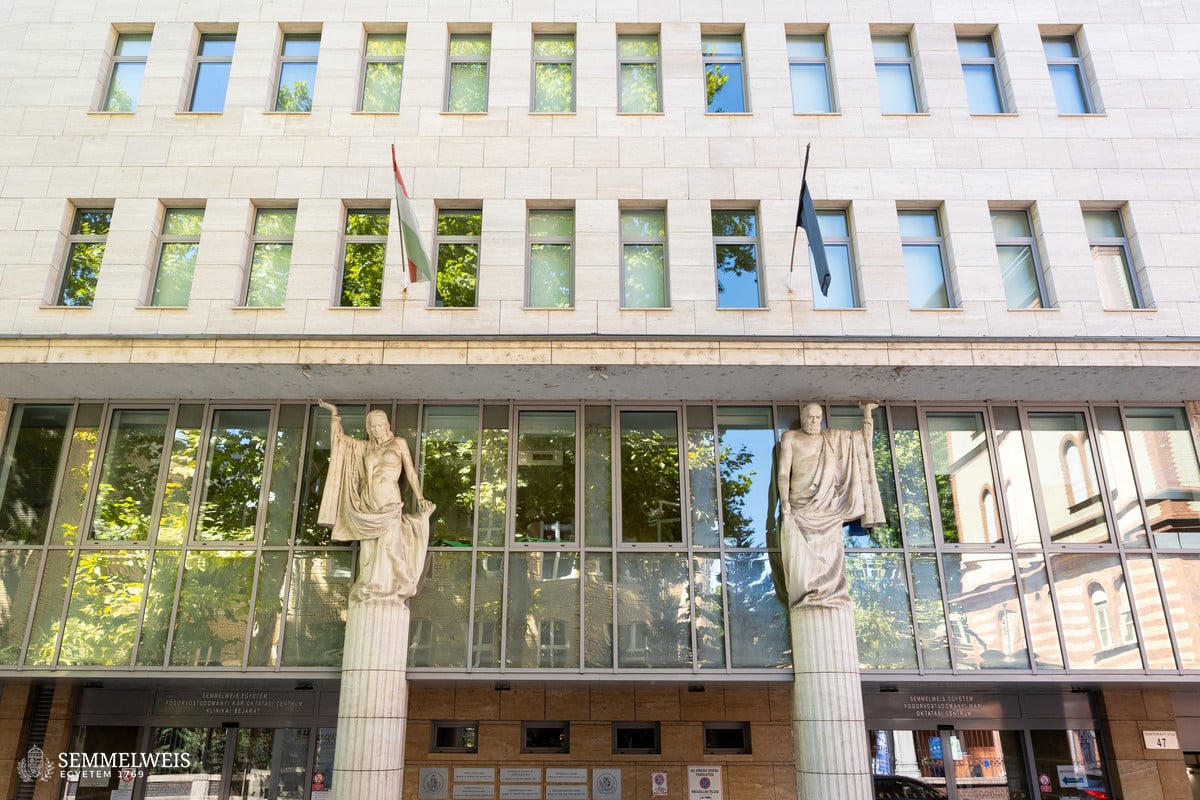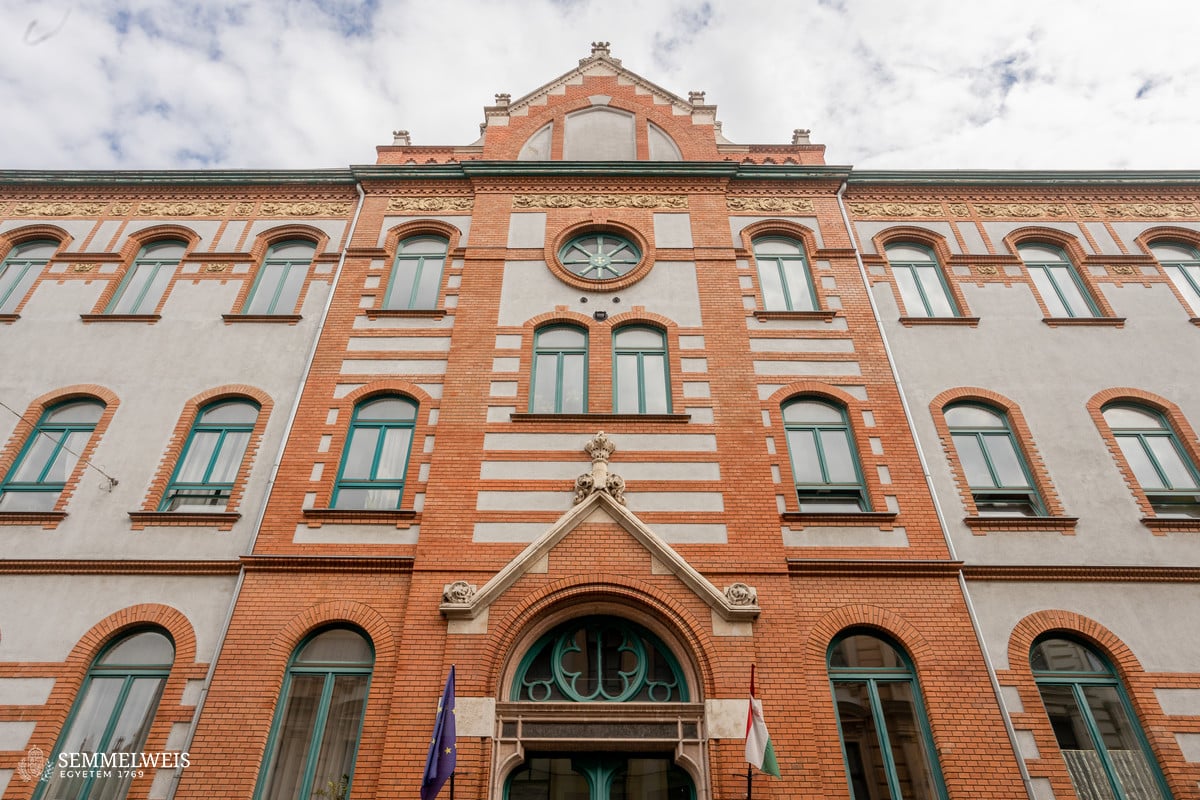The Faculty of Dentistry
University-level dentistry education dates back more than 180 years in Hungary. Modern-day training can be traced back to the opening of the University Dental Institute in 1890. The focus shifted from theoretical training to practical education. In 1909, the Stomatological Clinic, one of the best-equipped dental clinics in Europe at the time, was built and opened. Its structure and full range of equipment had been designed with the utmost consideration for educational and specialist medical training purposes. Dentistry was included as a compulsory subject in the medical curriculum in 1947. In September 1952, the Medical University of Budapest launched a new model of dental training. At the time, it was the only institution suitable for this purpose. The independent Faculty of Dentistry (FOK) was established in 1955, initially operating with just one clinic. In 1959, in addition to the Stomatology Clinic, which was the sole provider of education, three other departments were established: Conservative Dentistry, Prosthodontics, and Pediatric Dentistry and Orthodontics. Later, further organizational units were created, and currently, a total of 11 departments and clinics are affiliated with the faculty. The Dental Education Center on Szentkirályi Street was opened in 2007. In addition to Hungarian-language education, the training of international students is also of great importance. Over the past 70 years, 7,687 students have received their dental degrees from the faculty, including almost 1,500 international students from 36 countries. In addition to undergraduate education, significant achievements have also been made in recent years in the fields of specialist medical training and continuing education. The Secretariat for Postgraduate Specialist and Professional Training has earned recognition from the European community for its achievements in Hungary. In the 2022/23 academic year, the faculty launched a three-year BSc correspondence program in Digital Dental Design.
To celebrate the 70th anniversary of becoming an independent faculty, the Faculty of Dentistry will hold a two-day event. Current and former students from and outside of Hungary, as well as faculty staff, professors, researchers, and dental professionals from the country and abroad will be in attendance. From September 26 to 27, the Dean’s Office and the Alumni Board will organize a scientific meeting, a book launch, an anniversary certificate award ceremony, and a gala dinner to celebrate the event, which will take place at the Nagyvárad Square Theoretical Block. The refurbished and extended Dental Education Center will be presented as part of the celebrations. Dean Dr. Gábor Gerber noted that the first class at FOK comprised students who had transferred from the Faculty of Medicine in 1953 and graduated in 1955. “To mark this special anniversary, we would like to celebrate the history of the faculty and also highlight some of our ideas for the future. Let this festive year be an opportunity to connect the past, present, and future of dental education,” said the dean, who believes that this milestone anniversary is an excellent chance to look back and honor the memory of our predecessors. “Seventy years gives us sufficient perspective to assess the past and present state of dental education, and to rank the faculty within the domestic and international dental education space. According to the 2024 ShanghaiRanking, Semmelweis University is among the world’s top 300 universities for dentistry,” emphasized Dr. Gábor Gerber.
The Faculty of Pharmaceutical Sciences
The medical faculty of the University of Nagyszombat, which was established in 1769, took responsibility for pharmacy education from the outset. Women could enter the pharmaceutical profession in 1895. The 1940 reform brought about an important change: Students enrolled directly at the university after graduating from high school, and only during or after their university studies did they undertake practical training in public pharmacies (previously, practical training had to be completed after graduating from high school). In autumn 1955, preparations began for the establishment of an independent Faculty of Pharmaceutical Sciences (GYTK), and the first meeting of the Faculty Council took place in December. The 1972 curriculum significantly increased the ratio of hands-on training. Biochemistry was included in the curriculum as a separate subject, and anatomy was included in biology for one semester. Special emphasis was placed on pharmaceutical technology, drug control, pharmacodynamics and toxicology, pharmacognosy, and pharmaceutical management as specialized subjects. In 1988, GYTK launched its first English-language program, and the training period was extended to five years. Currently, approximately 800 students are enrolled in undergraduate programs, with international students accounting for 28 percent of the total.
Dean Dr. István Antal highlighted one of the faculty’s recent achievements, namely that students could now study under a curricular reform that emphasized hands-on education, enabling them to acquire not only a strong theoretical foundation but also the practical knowledge and approach that were essential in the rapidly evolving fields of pharmacy. He recalled that the Center for Pharmacology and Drug Research & Development was a major actor in research and development, adding that the recently established Richter Department and the Industrial Pharmaceutical Technology Laboratory also strengthen innovation and the faculty’s relations with the pharmaceutical industry. Dr. István Antal pointed out that over the past five years, the number of D1 publications related to the faculty had nearly tripled. He also added that ShanghaiRanking listed the university among the top 100 in the field of pharmaceutical sciences. The dean considers it a significant achievement that international students apply for the program from an increasing number of countries.
Speaking about the jubilee year, Dr. István Antal noted that, as the first faculty meeting of the independent GYTK took place in December 1955, the 70th anniversary would be celebrated on 13 December with a day-long event in the ceremonial hall of the Nagyvárad Square Theoretical Block. In addition to current and former students, distinguished alumni who have made notable achievements in their field are also invited to the event. The Hungarian Chamber of Pharmacists (MGYK), the Hungarian Pharmaceutical Society (MGYT), the Hungarian Pharmaceutical Manufacturers Association (MAGYOSZ), and the National Centre for Public Health and Pharmacy (NNGYK) will also be in attendance, in all of which organizations numerous former students have found employment and built careers.
The Faculty of Health Sciences
The legal predecessor of the Faculty of Health Sciences at Semmelweis University was the college faculty of Imre Haynal University of Health Sciences (HIETE), which began operating on January 1, 1956, as part of the Institute for Continuing Medical Education (OTKI). In 1973, the Presidential Council declared OTKI a university-level institution of higher education. In addition to providing vocational training and continuing education for doctors, pharmacists, and medical psychologists, the faculty was responsible for training the managers and chief physicians of healthcare institutions. At that time, with the establishment of the Faculty of Health Sciences, a two-faculty structure emerged. The new faculty provided training for healthcare workers with college degrees, while the Faculty of Continuing Medical Education provided continuing education for doctors and pharmacists. The College Faculty of Health Sciences held its first opening ceremony on September 2, 1975. Almost two decades later, in December 1994, the Faculty Council announced its intention to integrate with the then Semmelweis University of Medicine. This was completed in 2000, when the university adopted its current name and became Semmelweis University.
ETK is currently the university’s second largest faculty, offering the widest range of health science training programs in Hungary. In 2022, a new wing named after Zsuzsanna Kossuth was inaugurated, housing two large lecture halls, laboratories, and classrooms supporting hands-on training. When designing the building, great emphasis was placed on creating community spaces for students. With around 4,600 students, including an international community hailing from over 70 countries, the university boasts a diverse and vibrant environment. In addition to their teaching duties, faculty members are also involved in more than 100 research projects in a wide range of medical, health, and social sciences. ETK also publishes its own English-language open-access journal called Developments in Health Sciences (DHS).
Dean Dr. Gabriella Dörnyei Bednárikné revealed that the faculty would celebrate its 50th anniversary on November 26. According to the draft agenda, there will be a panel discussion with the participation of former senior lecturers and new departments. A commemorative plaque will be unveiled in honor of Professor Emeritus István Forgács, and a national drawing competition has been announced for elementary and secondary school students on the theme of the everyday life of healthcare professionals. An anniversary yearbook is also being prepared, and the celebration will conclude with a concert by the Medic Orchestra.
Eszter Keresztes
Translation: Judit Szabados-Dőtsch
Photos by Bálint Barta, Boglárka Zellei – Semmelweis University





